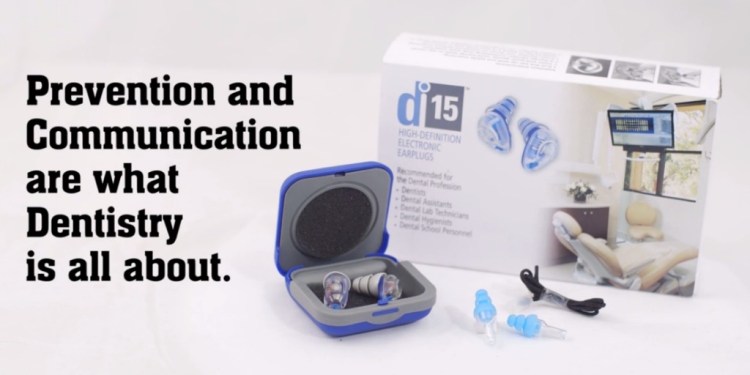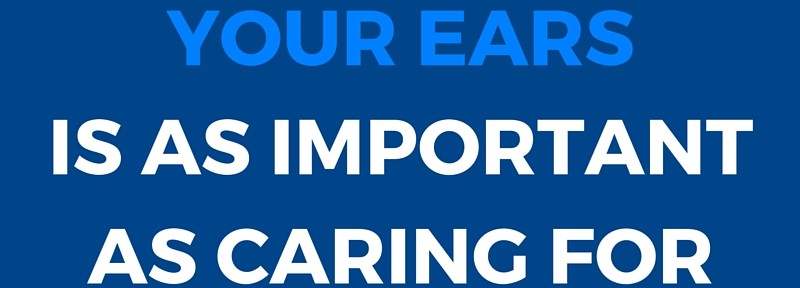 Ahhh, the busy hum of a bustling dental office. The chipper chatter of patients, the whir of a high-speed handpiece, the whoosh of the suction…all of this din may seem routine and comforting, but did you know it may also be dangerous?
Ahhh, the busy hum of a bustling dental office. The chipper chatter of patients, the whir of a high-speed handpiece, the whoosh of the suction…all of this din may seem routine and comforting, but did you know it may also be dangerous?
The National Institute on Deafness and Other Communication Disorders (NIDCD) website relays that approximately 15% of Americans ages 20-69 have high-frequency hearing loss that may have been caused by exposure to loud noises at work. Dental industry professionals in particular experience daily exposure to high frequency, high decibel sounds which can cause lasting and irreversible damage. Read on to find out why caring for your ears is just as important as caring for your patient’s teeth.
Some Striking Stats on Hearing Loss
In the United States and Canada, noise-induced hearing loss (NIHL) is the second most common occupational illness and injury reported! Thankfully for the 26 million Americans who are affected by this issue, the World Health Organization also dubs hearing loss the most preventable occupational hazard we face.
One of the trickiest aspects of hearing loss is that it is referred to as a “cumulative and additive” phenomenon. It is a gradual process most often resulting from small exposures over a long period of time. Due to this incremental progression along with the fact that it is painless, hearing loss generally goes unnoticed until damage is already extensive and irreversible. Once NIHL becomes permanent it is impossible to recover the hearing, and it is not a medically treatable condition.
As if affecting hearing isn’t enough, studies have shown that chronic exposure to high frequency, high decibel noises has direct links to systemic health affects including cardiovascular disease, depression, and sleep and cognitive functions, among others.
Both OSHA (Occupational Safety and Health Administration) and NIOSH (National Institute for Occupational Safety and Health) have set guidelines regarding the maximum permissible exposure limit to noises throughout an 8 hour day. OSHA dictates that levels should not exceed 90 decibels, while NIOSH is slightly more conservative, stating that “all worker exposure to noise be controlled below a level equivalent to 85 decibels for 8 hours to minimize occupational, noise-induced hearing loss.”
Why is the Dental Community at Greater Risk?
 Research has found that dental professionals have poorer hearing as compared to other health professionals. Published dental literature reveals that over a 15 year period of time in the dental industry, individuals have a significant decrease in hearing at high frequencies in both ears, and that this holds true for all ages and genders.
Research has found that dental professionals have poorer hearing as compared to other health professionals. Published dental literature reveals that over a 15 year period of time in the dental industry, individuals have a significant decrease in hearing at high frequencies in both ears, and that this holds true for all ages and genders.
Professionals in the dental industry are exposed to sound patterns that are referred to as “intermittent,” meaning periods of time when there are hazardous levels of sound alternate with periods of time where there are non-hazardous sound levels. The amount of noise which you are exposed to will depend on the type of treatment your practice provides, as well as the equipment that you use. There are several sources of high decibel, high frequency noises present in dental offices including:
- High-speed handpieces (high-speed handpieces can reach 89 dB)
- Ultrasonic instruments and cleaners (ultrasonic scalers can reach 107 dB)
- High-speed suctions (high volume suction pumps can reach 89 dB)
- Various lab equipment and devices (vibrating equipment can reach 96 dB)
Is There a Solution?
 Since noise-induced hearing loss is not medically treatable, prevention is the only solution. Dental professionals can’t simply “turn down their equipment” or walk away from the dangerous sounds, so in these instances NIOSH suggests that “if noise levels cannot be controlled, hearing protection devices such as earmuffs and earplugs can be considered an acceptable option.”
Since noise-induced hearing loss is not medically treatable, prevention is the only solution. Dental professionals can’t simply “turn down their equipment” or walk away from the dangerous sounds, so in these instances NIOSH suggests that “if noise levels cannot be controlled, hearing protection devices such as earmuffs and earplugs can be considered an acceptable option.”
Dr. Sam Shamardi, a board certified periodontist and clinical instructor at the Harvard Dental Division of Periodontics, recognized the need for a sophisticated solution and created DI-15 High Fidelity Electronic Earplugs. The advanced technology within this Patterson-exclusive product is expressly intended to prevent noise-induced hearing loss in the dental environment. In Shamardi’s own words,
“Being dentists, we always stress the issue of prevention, so I wanted to create something that would help address this issue within our field. This product is the only one of its kind, and is made by dentists for the dental community.”
How Does it Work?
 Far from the one-size-fits-all neon orange earplug varieties available at drugstores, DI-15 earplugs are “active,” which means they do more than simply block sound. Hearing is 100% natural when sounds are at safe levels as if nothing is in the ears at all, allowing for clear communication with patients and staff. As soon as dangerous noises are present in the environment, however, advanced micro-chip technology is activated and instantly compresses the offending sounds to safe levels.
Far from the one-size-fits-all neon orange earplug varieties available at drugstores, DI-15 earplugs are “active,” which means they do more than simply block sound. Hearing is 100% natural when sounds are at safe levels as if nothing is in the ears at all, allowing for clear communication with patients and staff. As soon as dangerous noises are present in the environment, however, advanced micro-chip technology is activated and instantly compresses the offending sounds to safe levels.
To use the earplugs, you simply pull up your ear to insert the product, then twist and push gently until the tip of the plug seals your ear canal.
Testimonials and Additional Information
Dental Innovations has created an informational video which contains testimonials from dental professionals, animated instructions for product use, and additional background on the impetus behind this innovative product’s creation. Take a look!
Purchasing Information
 DI-15 High Fidelity Electronic Earplug – Shop
DI-15 High Fidelity Electronic Earplug – Shop
The purchase of each exclusive earplug kit includes one pair of high-fidelity earplugs, a protective hard case, 7 pairs of ear tips for all sizes/shapes, 1 pack of batteries, cleaning tools, and a color instruction manual.
The Patterson Dental “Shop” page linked above contains additional information on the product, scholarly resources which we have cited throughout this post, as well as a free continuing education course which details the precautions and methods that can be employed to help prevent hearing loss.
When communicating with patients, dental professionals continuously emphasize the importance of preventative measures in oral healthcare. This one instance where a preventative approach is of equal importance to aural healthcare!





have hearing aids now since in Dentistry for 38 years ,but have to wear them to hear pts,but now hear noise better,,If I wear protective ear protectors I can’t hear the pt. I’ll be DR.Hu,what.So If you wit too long ,it’s worse